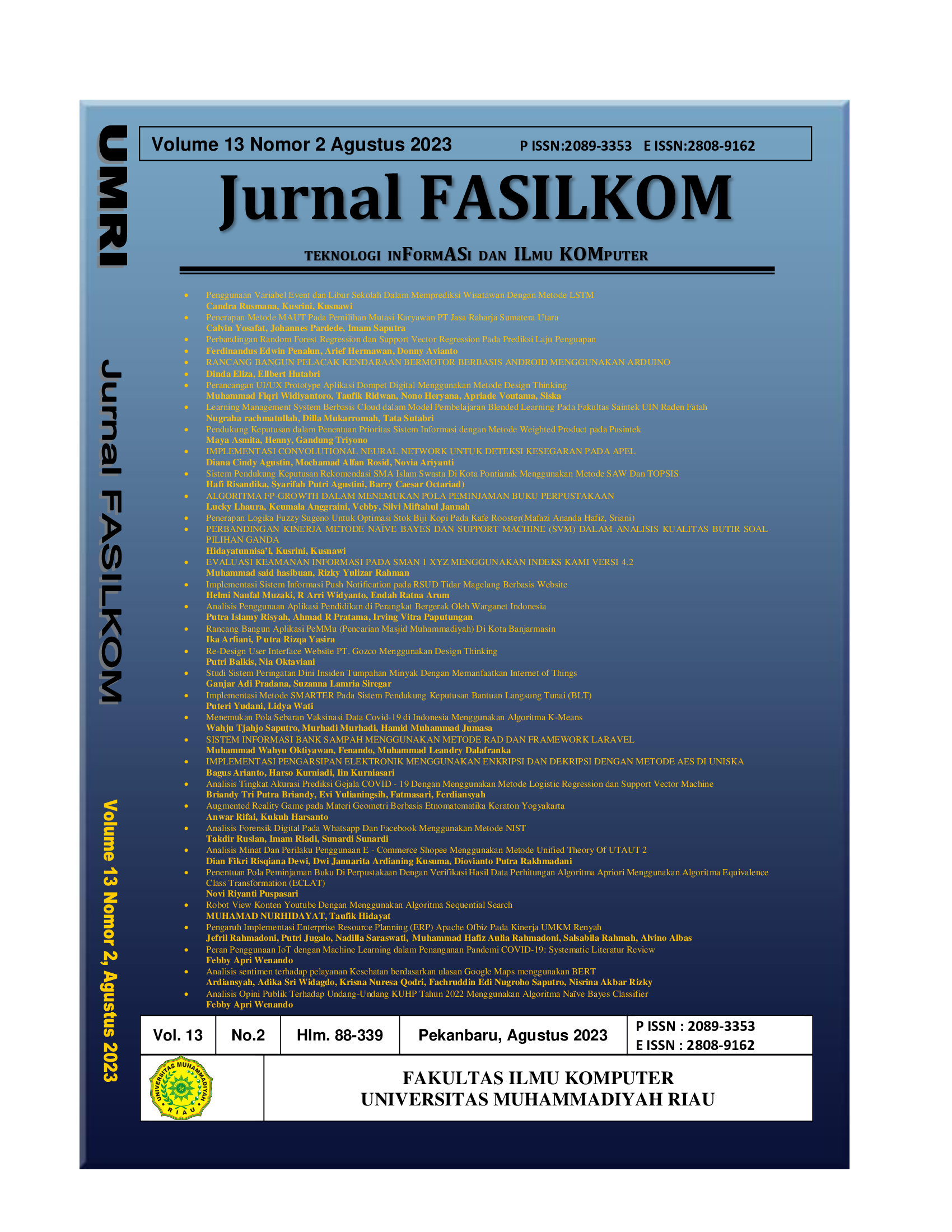Analisis Forensik Digital Pada Whatsapp Dan Facebook Menggunakan Metode NIST
Abstract
Technological developments can make it easier for Smartphone users to share various kinds of information using instant messaging applications such as Facebook Messenger and WhatsApp, the features contained in these instant messaging applications can send messages in the form of text, audio, images, videos and documents. The increase in the number of users of instant messaging applications also has a negative impact, namely the emergence of individuals who abuse instant messaging applications for digital crimes such as fraud, pornography, and drug sales. Disclosure of crimes requires valid digital evidence. In conducting investigations of digital crime cases, digital evidence is needed to solve them. Retrieval of digital evidence requires a forensic process of the physical evidence that has been obtained. This research focuses on the forensic process to obtain digital evidence from an Android Smartphone in the form of audio and video in the Facebook Messenger and WhatsApp applications. The forensic tools used in this research are Oxygen Forensic Pc Suite 2014, MOBILedit Forensic, Belkasoft evidence, and Magnet Axiom. The research uses a framework from the National Institute of Standards and Technology (NIST). The results of the research using the NIST method on an Android Smartphone were that Belkasoft succeeded in recovering deleted data with a percentage of 50% audio and 41% video on the WhatsApp application while on Facebook Messenger only 8.33% audio and 41% video, Magnet Axiom with a data percentage of 100%. audio and 100% video while Facebook Messenger has 8.33% audio and 5% video, on MOBILedit with a percentage of 0% on both applications, and Oxygen manages to return 16.67% audio and 23.5% video from the WhatsApp application and 0% for Facebook Messenger
Downloads
References
I. Riadi, Sunardi, and T. Ruslan, “FORENSIK MULTIMEDIA BERBASIS MOBILE MENGGUNAKAN METODE NATIONAL INSTITUTE OF JUSTICE,” S A I N T E K O M, vol. 12, no. 1, pp. 69–80, 2022.
F. Anggraini, H. Herman, and A. Yudhana, “Analisis Forensik Aplikasi TikTok Pada Smartphone Android Menggunakan Framework Association of Chief Police Officers,” JURIKOM (Jurnal Ris. Komputer), vol. 9, no. 4, p. 1117, 2022, doi: 10.30865/jurikom.v9i4.4738.
I. A. Plianda and R. Indrayani, “Analisa dan Perbandingan Performa Tools Forensik Digital pada Smartphone Android menggunakan Instant Messaging Whatsapp,” J. Media Inform. Budidarma, vol. 6, no. 1, pp. 500–506, 2022, doi: 10.30865/mib.v6i1.3487.
R. Majalista and T. Sutabri, “ANALISIS PENCARIAN DATA SMARTPHONE MENGGUNAKAN NIST UNTUK PENYELIDIKAN DIGITAL FORENSIK,” JINTEKS (Jurnal Inform. Teknol. dan Sains), vol. 3, no. 2, pp. 81–91, 2021.
A. Al-Dhaqm, S. A. Razak, R. A. Ikuesan, V. R. Kebande, and K. Siddique, “A review of mobile forensic investigation process models,” IEEE Access, vol. 8, no. 1, pp. 173359–173375, 2020, doi: 10.1109/ACCESS.2020.3014615.
N. Saputri and R. Indrayani, “Analisis Data Forensik Investigasi Kasus Peredaran Narkoba Pada Smartphone Berbasis Android,” Djtechno J. Teknol. Inf., vol. 3, no. 2, pp. 156–166, 2022, doi: 10.46576/djtechno.v3i2.2597.
S. Pambayun and I. Riadi, “Investigation on Instagram Android-based using Digital Forensics Research Workshop Framework,” Int. J. Comput. Appl., vol. 175, no. 35, pp. 15–21, 2020, doi: 10.5120/ijca2020920904.
N. Hoang Khoa, P. The Duy, H. Do Hoang, D. Thi Thu Hien, and V. H. Pham, “Forensic analysis of TikTok application to seek digital artifacts on Android smartphone,” Proc. - 2020 RIVF Int. Conf. Comput. Commun. Technol. RIVF 2020, 2020, doi: 10.1109/RIVF48685.2020.9140739.
G. Fanani, I. Riadi, and A. Yudhana, “Analisis Forensik Aplikasi Michat Menggunakan Metode Digital Forensics Research Workshop,” J. Media Inform. Budidarma, vol. 6, no. 2, p. 1263, 2022, doi: 10.30865/mib.v6i2.3946.
A. N. Ichsan and I. Riadi, “Mobile Forensic on Android-based IMO Messenger Services using Digital Forensic Research Workshop (DFRWS) Method,” Int. J. Comput. Appl., vol. 174, no. 18, pp. 34–40, 2021, doi: 10.5120/ijca2021921076.
N. Nasirudin, S. Sunardi, and I. Riadi, “Analisis Forensik Smartphone Android Menggunakan Metode NIST dan Tool MOBILedit Forensic Express,” J. Inform. Univ. Pamulang, vol. 5, no. 1, p. 89, 2020, doi: 10.32493/informatika.v5i1.4578.
I. Riadi, Sunardi, and Sahiruddin, “PERBANDINGAN TOOL FORENSIK DATA RECOVERY BERBASIS ANDROID FORENSIC TOOL COMPARISON DATA RECOVERY BASED ANDROID,” J. Teknol. Inf. dan Ilmu Komput., vol. 7, no. 1, pp. 197–204, 2020, doi: 10.25126/jtiik.202071921.
V. Fernando, “Cyber Forensics Tools: A Review on Mechanism and Emerging Challenges,” in 2021 11th IFIP International Conference on New Technologies, Mobility and Security, NTMS 2021, 2021, pp. 1–7. doi: 10.1109/NTMS49979.2021.9432641.
Imam Riadi, Rusydi Umar, and M. I. Syahib, “Akuisisi Bukti Digital Viber Messenger Android Menggunakan Metode National Institute of Standards and Technology (NIST),” J. RESTI (Rekayasa Sist. dan Teknol. Informasi), vol. 5, no. 1, pp. 45–54, 2021, doi: 10.29207/resti.v5i1.2626.
H. H. Lwin, W. P. Aung, and K. K. Lin, “Comparative Analysis of Android Mobile Forensics Tools,” in IEEE Conference on Computer Applications, ICCA 2020, 2020, pp. 1–6. doi: 10.1109/ICCA49400.2020.9022838.
Soni, D. Sudyana, Y. Prayudi, H. Mukhtar, and B. Sugiantoro, “Server Virtualization Acquisition Using Live Forensics Method,” Advances in Engineering Research, Vol. 190, Pp. 18–23, 2019. https://dx.doi.org/10.2991/iccelst-st-19.2019.4
Copyright (c) 2023 Takdir Ruslan, Imam Riadi, Sunardi Sunardi (Author)

This work is licensed under a Creative Commons Attribution-ShareAlike 4.0 International License.
Copyright Notice
An author who publishes in the Jurnal FASILKOM (teknologi inFormASi dan ILmu KOMputer) agrees to the following terms:
- Author retains the copyright and grants the journal the right of first publication of the work simultaneously licensed under the Creative Commons Attribution-ShareAlike 4.0 License that allows others to share the work with an acknowledgement of the work's authorship and initial publication in this journal
- Author is able to enter into separate, additional contractual arrangements for the non-exclusive distribution of the journal's published version of the work (e.g., post it to an institutional repository or publish it in a book) with the acknowledgement of its initial publication in this journal.
- Author is permitted and encouraged to post his/her work online (e.g., in institutional repositories or on their website) prior to and during the submission process, as it can lead to productive exchanges, as well as earlier and greater citation of the published work (See The Effect of Open Access).
Read more about the Creative Commons Attribution-ShareAlike 4.0 Licence here: https://creativecommons.org/licenses/by-sa/4.0/.
 Abstract views: 420 ,
Abstract views: 420 ,  Pdf downloads: 324
Pdf downloads: 324













_(1).png)


